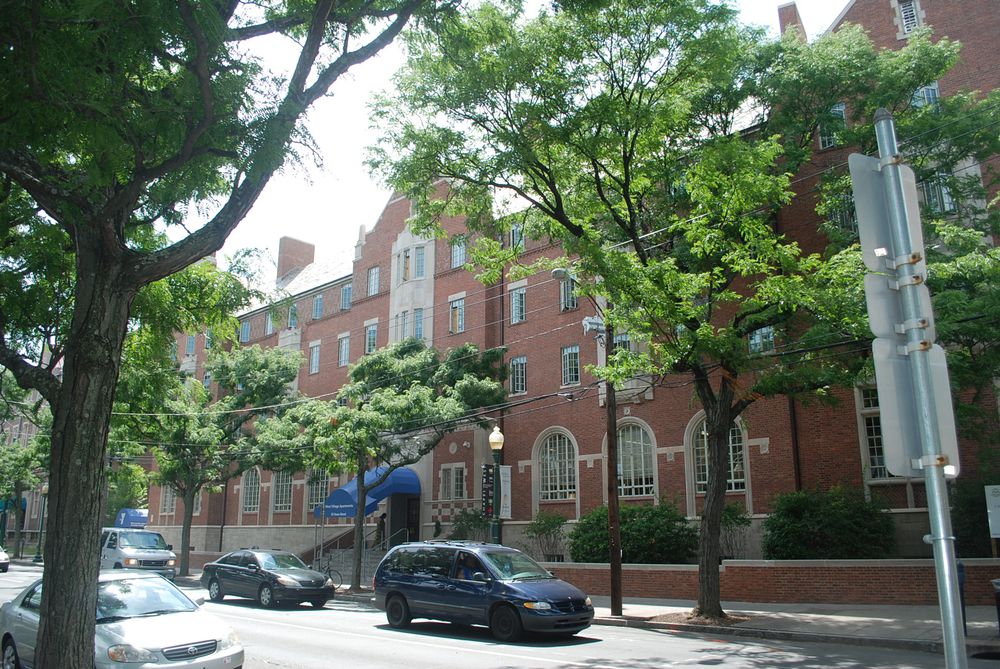
52 Howe Street, New Haven, CT
This large building was designed by architect Douglas Orr, a notable New Haven architect of the early twentieth century, around 1930 for the Young Men’s Christian Association of New Haven. YMCA national was founded in 1851 and arrived in New Haven fifteen years later in 1866. Their first building was erected on Temple Street and their operations quickly expanded with four more branches sprouting in New Haven, including one at Yale’s Dwight Hall in 1910. The New Haven Historical Society records say that the YMCA purchased four houses on the corner of Howe and Chapel Streets in 1919 and erected a central branch for their New Haven operations on the site in 1924. However, it appears this information may be faulty. The White Brothers’ title searches for this site show that the YMCA purchased it from Henry P. Sage on May 28, 1921. Additionally, there is a plaque above the main entrance of the building that dates it to 1922. In any event, this building fronts on Chapel Street and not Howe. However, it appears that the Historical Society was correct in their assessment that this central branch had a swimming pool and gymnasium. The western façade has glass block windows on the ground level (typical for a swimming pool) and has metal grating in front of the windows on the fourth floor (typical for a gymnasium).
The building fronting on Howe Street has a cornerstone dating it to 1931. This corner building, 52-56 Howe Street, seems to be on the land of four houses, as shown by Sanborn Maps and the White Brothers’ record. It was the last building of the YMCA complex that was built, completed just two years after the YWCA to its south, and is the most ornate and impressive of the three, signaling the strength of the financial support of the New Haven community. It seems that the building was a center for social activities in the Howe Street Neighborhood, not only for the youth, but also for young adults. At the New Haven Historical Society, I was regaled by the historian who fondly remembered going to dances there when soldiers returned home from World War II. The building maintained its status as the anchor of the community through the 1980s.
In 1986, a group of community activists called the Upper Chapel Neighborhood Improvement Association gathered in the building and drew up a plan for “Chapel West,” a special services district. The district lines Chapel Street and Howe Street with the YMCA as its core (see map). Together, they drew up plans for providing security for the neighborhood, bringing investors in, providing a new image for the neighborhood, and maintaining clean streets, parks and buildings.
Currently, the headquarters for Chapel West are across the street. In the early 1990s, the YMCA’s operation shrank to a small recessed part of the building in between the YMCA and the YWCA. The building is now called the “Village West Apartments” and contains 148 “efficiency apartments,” small studios, each with a kitchenette and bathroom. This last renovation occurred in 2002, and maintained the beautiful wood paneling covering the walls of the first floor. Whatever becomes of the building next, it will surely maintain its historical significance as the YMCA, the center of the Chapel West Neighborhood.
The building fronting on Howe Street has a cornerstone dating it to 1931. This corner building, 52-56 Howe Street, seems to be on the land of four houses, as shown by Sanborn Maps and the White Brothers’ record. It was the last building of the YMCA complex that was built, completed just two years after the YWCA to its south, and is the most ornate and impressive of the three, signaling the strength of the financial support of the New Haven community. It seems that the building was a center for social activities in the Howe Street Neighborhood, not only for the youth, but also for young adults. At the New Haven Historical Society, I was regaled by the historian who fondly remembered going to dances there when soldiers returned home from World War II. The building maintained its status as the anchor of the community through the 1980s.
In 1986, a group of community activists called the Upper Chapel Neighborhood Improvement Association gathered in the building and drew up a plan for “Chapel West,” a special services district. The district lines Chapel Street and Howe Street with the YMCA as its core (see map). Together, they drew up plans for providing security for the neighborhood, bringing investors in, providing a new image for the neighborhood, and maintaining clean streets, parks and buildings.
Currently, the headquarters for Chapel West are across the street. In the early 1990s, the YMCA’s operation shrank to a small recessed part of the building in between the YMCA and the YWCA. The building is now called the “Village West Apartments” and contains 148 “efficiency apartments,” small studios, each with a kitchenette and bathroom. This last renovation occurred in 2002, and maintained the beautiful wood paneling covering the walls of the first floor. Whatever becomes of the building next, it will surely maintain its historical significance as the YMCA, the center of the Chapel West Neighborhood.
Researcher
Daniel H. Fuchs
Date Researched
Entry Created
June 4, 2017 at 8:47 AM EST
Last Updated
June 4, 2017 at 8:47 AM EST by null
Historic Name
Style
Current Use
Era
1910-1950Neighborhood
Chapel WestTours
Historic Chapel West and Dwight EdgewoodYear Built
1931
Architect
Douglas Orr
Current Tenant
Roof Types
Structural Conditions
Street Visibilities
Threats
External Conditions
Dimensions
Street Visibilities
Owner
Ownernishp Type
Client
Young Men's Christian Association of New Haven
Historic Uses
Mixed Use
Comments
You are not logged in! Please log in to comment.